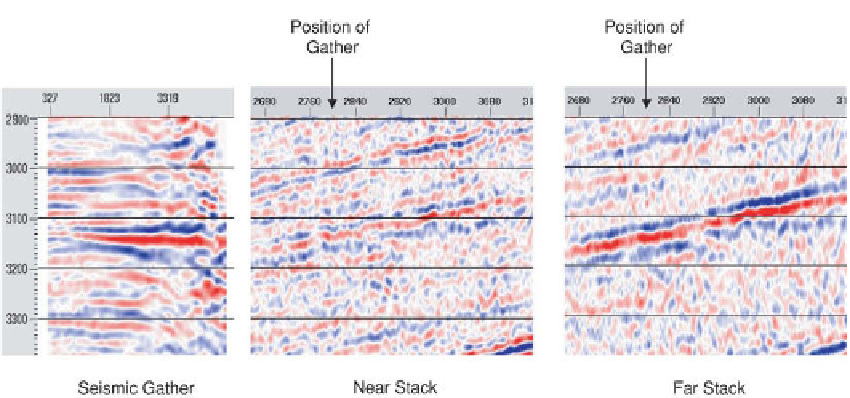Geoscience Reference
In-Depth Information
Fig. 5.12
Near and far stacks for a class III sand. Polarity: red
=
soft (impedance decrease
downwards).
near and far data can then be stacked and migrated. The resulting near and far volumes
can be loaded to an interpretation workstation and treated in exactly the same way as
the full offset range data.
Figure 5.12
shows an example for the case of a class III sand
with marked brightening to the far offsets. The result is that the far stack shows a very
strong event at the target level. This approach has several advantages.
(1) The signal to noise ratio of the near and far stacks is high compared with that of a
gather.
(2) The horizon interpretation can be copied from the full to the far and near offset
data; if residual moveout (due to inaccurate NMO correction) is a problem, the
small adjustments to centre the horizons on the appropriate loop can be done semi-
automatically. It is then possible to work with amplitude maps of a given reflector
on nears and fars as a way of extracting AVO response. This removes much of the
residual moveout problem encountered in gradient estimation, though the problem
will still cause a degree of mis-stacking and so affect the amplitudes of the near
and far displays. Sometimes, in the case of a class IIp response or where complex
interference causes big changes in the appearance of reflectors from nears to fars, it
may be hard to recognise corresponding reflectors on the two sub-stacks; modelling
the expected response from a well dataset may be helpful.
(3) Scanning through the appropriate sub-stack volume (especially the far traces for
class III) is a quick way to look for anomalous amplitudes. It is much faster than
scanning through gathers; the volume of data is less, of course, but also it is possible
to get an immediate impression of how amplitude anomalies relate to structure.
Being able to view far and near trace sections together (in adjacent windows on the
screen) is a powerful aid to understanding.

